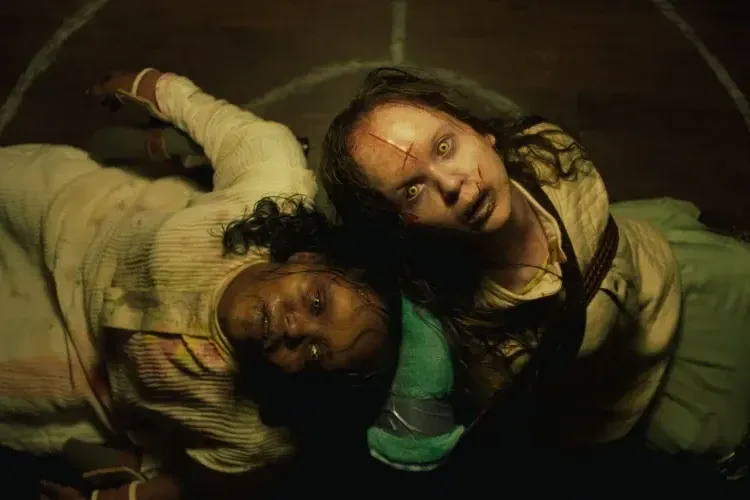Warning: This article contains spoilers.
When you see a movie with the word “exorcist” in the title, you expect it is going to have demonic themes. This one is no exception.
The Exorcist: Believer has all the levitating, voice-altering, body-dismembering, blood-puking gore that we have come to expect from Hollywood's overly dramatized presentation of demonic possession.
But hidden beneath all the theatrics, quietly lying alongside the story that is trying to be told, there is a dark undertone of truly demonic ideas that strike at the spiritual battle we face today, and it is these ideas we will address in this review.
Synopsis
The main characters in the movie are a single father named Victor and his thirteen-year-old daughter Angela. In the opening act, we learn that Victor’s wife died in a tragic accident while pregnant with Angela, and that the only way for Angela to live was for her mother to die.
The meat of the story begins with Angela and her friend Katherine wandering off into the forest, Angela with a deep-seated desire to speak with her deceased mother, and Katherine with a pagan conception of how to talk to the dead.
As the two hunker down in a small concrete structure out in the woods, they begin making efforts to contact the dead, and with this, a demon is conjured.
As the demon takes control of the two girls, Victor along with Katherine’s parents scramble to figure out how to help their daughters.
Hidden beneath all the theatrics, quietly lying alongside the story, there is a dark undertone of truly demonic ideas that strike at the true spiritual battle we face today.
Here begins the second act of the movie, where Victor and a Roman Catholic nurse assemble a motley crew of spiritual advisors spanning a variety of theological perspectives. Among them are Angela’s Baptist pastor, Victor’s charismatic neighbor, a very fearful Roman Catholic priest, and a woman who practices an ancient pagan religion akin to Haitian voodoo with some quasi-Christian elements.
Interestingly, of the entire cast of clergy, it is the pagan woman who takes the lead in carrying out the exorcism, calling upon ancient earth-based practices to drive out the demon. In the midst of the pagan rituals, all who are involved appeal to the demon to leave on the basis of their own faith tradition.
In the final act, the group fails to remain unified, and they are ultimately defeated by the demon as only one of the girls lives, and the other is taken by the demon as a sacrifice.
The Truly Demonic
So what are the elements of this movie that make it demonic in more ways than one?
According to the Bible, the demonic realm wars fundamentally in the arena of ideas and actions (1 Timothy 4:1, James 3:14-16). Since this is the case, the wiles of the enemy are far more subtle than is often portrayed in Hollywood movies.
In this way movies like The Exorcist: Believer play into the hand of the demonic realm, because while overdramatizing demonic possession they allow the truly demonic to fly under the radar by means of subtle deception and incremental temptation.
Though the Bible does teach that there are times when demons do manifest themselves in some supernatural display (Acts 19:16), this is not how demons commonly behave, even in the New Testament.
Additionally, because these movies are so overly dramatized, they also serve to pique the curiosity of unsuspecting onlookers, and can have the effect of encouraging curiosity around matters we are commanded not to investigate (Deuteronomy 18:9-14).
Another demonic element to The Exorcist: Believer is the specific worldview that it advances. The demonic doctrines of feminism and syncretism in this movie are palpable.
Early on in the movie one of the primary characters complains about the “patriarchy” within the Catholic rite of exorcism. But later in the movie, the Roman Catholic Church is unwilling to sanction an exorcism, and the young priest does not have the courage to perform the exorcism himself. Instead, he hands over his crucifix and his prayer book to the nurse and tells her to do it for him instead.
Because these movies are so overly dramatized, they also serve to pique the curiosity of unsuspecting onlookers, and can have the effect of encouraging curiosity around matters we are commanded not to investigate.
As the exorcism proceeds, things are not going well, and the demon begins to take the upper hand. But just when it looks like all hope has failed, the priest comes roaring into the exorcism, boldly proclaiming lines from the Catholic rites, and suddenly the power dynamic shifts and the demon is knocked back on its heels.
For a brief moment, it looks like the patriarchy is going to save the day. But then, suddenly, the demon regains control of the situation, and very graphically snaps the neck of the priest, leaving the rest of the team dazed and hopeless.
What’s interesting about the series of events I described above is that the movie plays out as though it is this event, the demise of the priest, which all of the other events are driving toward.
The primary message is not that good wins the day or that the darkness can be overcome by light. No, quite to the contrary, the primary message is that it would be better for the little girls to die than it would be for the religious patriarchy to save the day.
And that, my friends, is a truly demonic message!
At the same time the movie weaves in the demonic doctrine of syncretism. While the team is assembled for the exorcism, the voodoo witch doctor draws a series of ancient pagan symbols on the floor that are supposed to protect both of the girls, and the team, from the demon.
Another demonic element to The Exorcist: Believer is the specific worldview that it advances. The demonic doctrines of feminism and syncretism in this movie are palpable.
Throughout the exorcism, the witch doctor takes the lead, using various dirt and herb-based ancient practices, while the others bring their own religious practices into the ceremony, all operating on the pretense that each brings some important element to the exorcism.
The movie repeatedly asserts that all cultures at all times have participated in the rite of exorcism, and that all of these different religious practices have equally valid traditions to expel demons.
Throughout the exorcism the Roman Catholic nurse, the charismatic neighbor, the Baptist pastor, and the voodoo witch doctor all participate in various incantations in which they all to some degree follow the lead of the witch doctor, but also incorporate their own religious practices.
Ultimately, they are defeated because they do not stay together. Eventually the demon is able to break their unity, and that is its pathway to victory.
The two subtle narratives of this movie are that it is better for the girls to die than for the patriarchy to protect them, and the only way to defeat evil is for the religious systems to combine together, set aside their differences, and unify around their mission. However, the Bible states clearly that the church is to be led by upright men rather than women, a reality embedded in creation order (1 Timothy 2:12-14), while the Bible says that the only way to be saved or to access the throne room of heaven is through Jesus Christ and his gospel (Hebrews 10:19, John 3:36).
The subtle contradictions of these biblical truths are doctrines of demons, and they are among the predominant errors embraced in our culture.
Conclusion
While it should be clear that I would strongly urge Christians not to see this film, there is a greater point I want the reader to take away.
It is important for Christians to understand that hiding under the Hollywood dramatization of demonic possession in this film, and others like it, is a truly demonic message that is genuinely seeking to carry people away into pagan, godless worship. It is the task of the Christian to see this error and to oppose it with the truth.
The subtle contradictions of biblical truths are doctrines of demons, and they are among the predominant errors embraced in our culture.
This practice of faithfully opposing error with truth is the most important aspect of true spiritual battle. Gratefully, God has equipped us with what we need in his Word and by his Spirit so that believers can win the battle.
We do not need extraordinary weapons, ancient pagan practices, or even crucifixes and so-called holy water. Just the regular old common means of grace, such as sincere prayer to God in a true faith in Jesus Christ, will be sufficient as weapons of our warfare.



